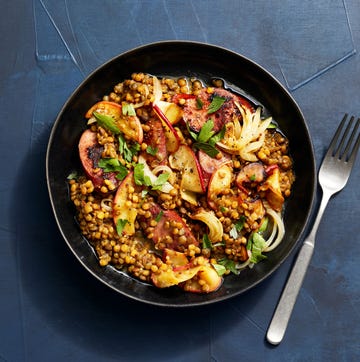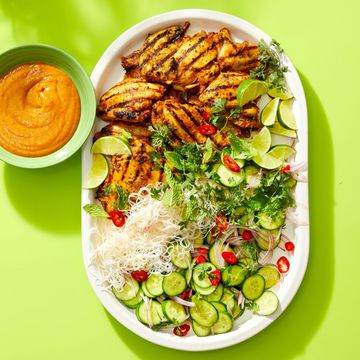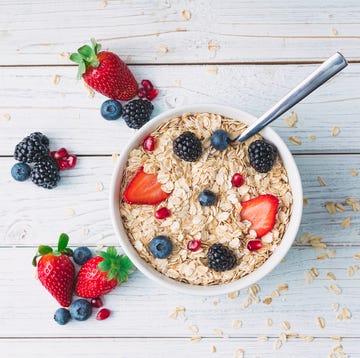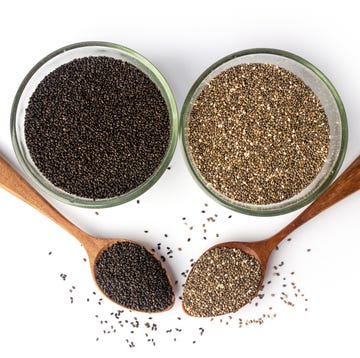When it comes to social media health trends, “sensible” is probably not the first thought that crosses your mind. Mouth taping, bone smashing, putting potatoes in your socks to rid yourself of toxins? Unfollow!
But the new TikTok trend of “fibermaxxing,” or prioritizing eating high fiber foods throughout the day, is actually good for you — as long as you don't go overboard. We spoke to several experts about the role of fiber in our diets, and how fibermaxxing can benefit our health.
Why is fiber important?
First, a quick reminder about the two types of fiber, soluble and insoluble:
- Soluble fiber dissolves in water and helps keep blood sugar and cholesterol levels in check. “It’s important to have each type in your diet,” says Isabella D’Ambra, MS, RD, LDN, a registered dietitian nutritionist at Beth Israel Deaconess Hospital in Needham, MA. “Soluble fiber is found in foods like fruits, vegetables, beans, and seeds. It turns into a gel-like substance that can help pass food through your digestive system more easily."
- Insoluble fiber is found in whole grains, oats, as well as fruits and vegetables, and doesn’t form the same gel-like substance, because it doesn’t dissolve in water. Instead, it moves with food through your gastrointestinal tract.” This means insoluble fiber helps you have regular bowel movements, because it zips the food you eat along quickly.
Dietary fiber, which is plentiful in many whole foods, is vital for keeping you healthy. “Fiber is a type of carbohydrate that’s beneficial for gut health, among other things,” says Monica Kelly, MS, RD, CDN, CNSC, associate health and wellbeing manager at Montefiore Einstein in Bronx, NY.
Fiber also plays a role in regulating blood sugar levels and can be very helpful for weight management. “It’s hard to digest, so it keeps us feeling full for longer and slows down digestion of sugar from carbohydrates,” says Sandra (Yujia) Zhang, MS, RDN, LDN, a registered dietician nutritionist and pediatric dietitian at the Frances Stern Nutrition Center at Tufts Medical Center in Boston, MA. “Fiber also helps lower LDL cholesterol.”
In a 2017 "umbrella" review in The Journal of Chiropractic Medicine, experts synthesized findings from multiple systematic reviews and meta-analyses and found that individuals “consuming the highest amounts of dietary fiber intake can significantly reduce their incidence and mortality from cardiovascular disease."
It’s important you eat enough fiber to make all these great functions happen. According to USDA, the daily adequate intake for fiber is 25 grams for women and 38 grams for men.
What is fibermaxxing?
Fibermaxxing is a strategy to ensure you eat fiber consistently. “Fibermaxxing is a nutrition trend that encourages maximizing fiber in meals and snacks throughout the day,” says D’Ambra.
Fibermaxxing isn’t about complicated meals — you don’t have to have a set number of grams of fiber for breakfast, for example. Instead, just combining a few fiber-rich foods, like oatmeal with blueberries and almonds, is a super-easy and effective way to hit your daily requirement.
Keep in mind, though, that “maxxing” doesn’t mean overdoing fiber to the point where you get an uncomfy side effect, like diarrhea — more on that later. Think of this strategy more as maximizing the health benefits you get by meeting your daily requirement, nor exceeding it.
“Include one fiber-rich food at one meal for a few days, then add to another meal to increase your overall fiber intake,” Zhang recommends.
Once you get familiar with good sources of fiber, you can stock your kitchen. Here’s a list to get you started:
High fiber produce
- Fruit: raspberries (one cup is 8 grams of fiber); pear (one medium is 5.5 grams of fiber); apple (one medium is 4.5 grams of fiber); banana (one medium is 3 grams of fiber); orange (one medium is 3 grams of fiber); strawberries (one cup is 3 grams of fiber)
- Vegetables: green peas (one cup is 9 grams of fiber); broccoli (one cup is 5 grams of fiber); turnips (one cup is 5 grams of fiber); Brussels sprouts (one cup is 4.5 grams of fiber); baked potato (one medium is 4 grams of fiber); sweet corn (one cup is 4 grams of fiber); cauliflower (1 cup is 2 grams of fiber); carrot (one medium is 1.5 grams of fiber)
High fiber nuts and grains & other foods
- Nuts & grains: barley (one cup is 6 grams of fiber); quinoa (one cup is 5 grams of fiber); oatmeal (one cup is 4 grams of fiber); brown rice (one cup is 3.5 grams of fiber); whole-wheat bread (one slice is 2 grams of fiber); rye bread (one slice is 2 grams of fiber); almonds (one ounce is 3.5 grams of fiber); pistachios (one ounce is 3 grams of fiber); sunflower kernels (one-quarter cup is 3 grams of fiber)
- Other foods: whole grain spaghetti (one cup is 6 grams of fiber); bran flakes (¾ cup is 5.5 grams of fiber); oat bran muffin (one medium is 5 grams of fiber); air-popped popcorn (three cups is 3.5 grams of fiber); split peas (one cup is 16 grams of fiber); lentils (one cup is 15.5 grams of fiber); black beans (one cup is 15 grams of fiber)
Making snack plates of different combos of these foods can be a tasty way to fibermax. “Chia seeds are also very high in fiber – one tablespoon has just about 10 grams,” D’Ambra adds. “Sprinkling chia into smoothies, yogurt, pudding, stir-fry, and oatmeal are easy ways to get more fiber.
What’s the right way to fibermax?
Keep moderation in mind, especially at first. “You want to gradually increase foods like fruit, vegetables, chickpeas and lentils,” advises Kelly. “Every week, try eating more fiber. You also want to increase hydration.” Constipation can happen if you don’t drink enough water, even as you up your intake of fiber.
Another good rule of thumb: make fruits and veggies half of your meals and snacks, says Zhang. That said, you can indeed eat too much fiber. Some influencers are encouraging people to eat 50 or even 100 grams of fiber a day–but that’s going overboard. Your best bet: stick to your daily requirement amount (25 grams for women; 38 for men). “If your diet has been low in fiber, increasing your intake slowly allows your body to adjust,” Zhang adds. “Too much fiber at once can lead to gastrointestinal issues, such as indigestion, bloating, gas, and abdominal pain.”
If you feel discomfort, lower your fiber intake and see if your symptoms go away. If they don’t, check in with your healthcare provider before upping your fiber intake again.
The bottom line
Getting enough fiber is essential for your body to function well — and fibermaxxing, within reason, is a great way to accomplish that. An important final note: get your fiber from food rather than through a supplement, unless your HCP advises you otherwise. “Fiber supplements often only provide a single source and type of fiber,” Zhang sums up. “Starting fiber supplements in large amounts can easily lead to GI upsets.” Eating more fiber will not only make you feel good, it’s really delicious as well.
Stefani (she/her) is a registered dietitian, a NASM-certified personal trainer and the director of the Good Housekeeping Institute Nutrition and Fitness Lab, where she oversees all nutrition and fitness-related content, testing and evaluation. She holds a master’s degree in clinical nutrition from New York University, as well as advanced certifications as a Women's Fitness Specialist and a Behavior Change Specialist. Stefani is dedicated to providing readers with evidence-based content to encourage informed food choices and healthy living. She is an avid CrossFitter and a passionate home cook who loves spending time with her big fit Greek family.













